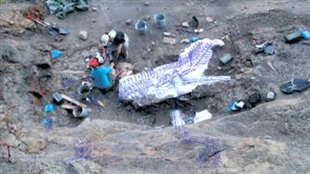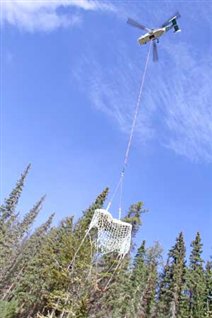It had long been thought that British Columbia was relatively devoid of fossils. Now palaeontologists have recovered the most complete hadrosaur skeleton- or duck-billed dinosaur-in the west coast province.

Up until 2002, only two dinosaur remains had been found in B.C. when a concentration was found in the northern portion of the province, close to the Alberta boundary near the town of Tumbler Ridge.
Various bits and pieces of a number of dinosaurs were uncovered in rocks estimated to be about 97 million years old, making it one of the oldest sites in western Canada.
Palaeontologists found another site nearby in 2007, in an area which was an ancient forested bog, some 75 million years ago. After finding several bone fossils, in 2008 they found one relatively complete hadrosaur, minus the head.

Lisa Buckley, curator and collections manager with the Peace Region Palaeontology Research Centre. She says the family of plant-eating hadrosaurids, “are the ones that had the really funky head gear, like the big long tubes extending back over the head, or the big frill running down the centre of the head,”
Richard McCrea, a paleontologist with the Tumbler Ridge Museum, said it’s possible the hadrosaur’s head and perhaps a portion of the carcass was scavenged by tyrannosaurs
Many juvenile Tyrannosaurus teeth were also found at the site.

McCrea said his team hopes to uncover more hadrosaurs at the site as they tended to live in herds. The recovered skeleton will be prepared and ready for display at possibly in a year.

McCrea said the hadrosaur skeleton is proof that B.C.’s paleontological history needs to be taken more seriously. He added that the excavation took so long partly because his six-member team operates on such a small budget. He notes that to dig into the hill, vast amounts of overburden must be slowly, and carefully removed which is a painstaking and time-consuming task.
(with files from CBC and Historica Dominion Institute)







For reasons beyond our control, and for an undetermined period of time, our comment section is now closed. However, our social networks remain open to your contributions.